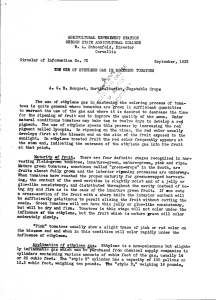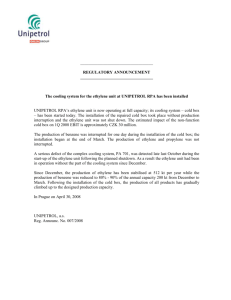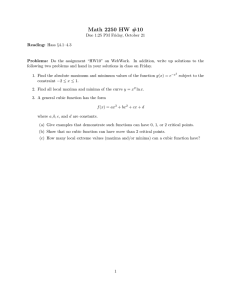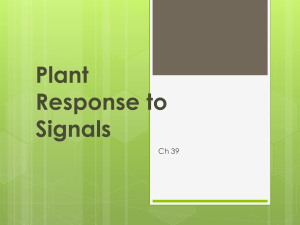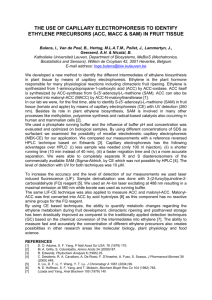AGRICULTURAL EXPERIMENT STATION Wm, A. Schoenfeld, Director Circular of Information No. 249
advertisement
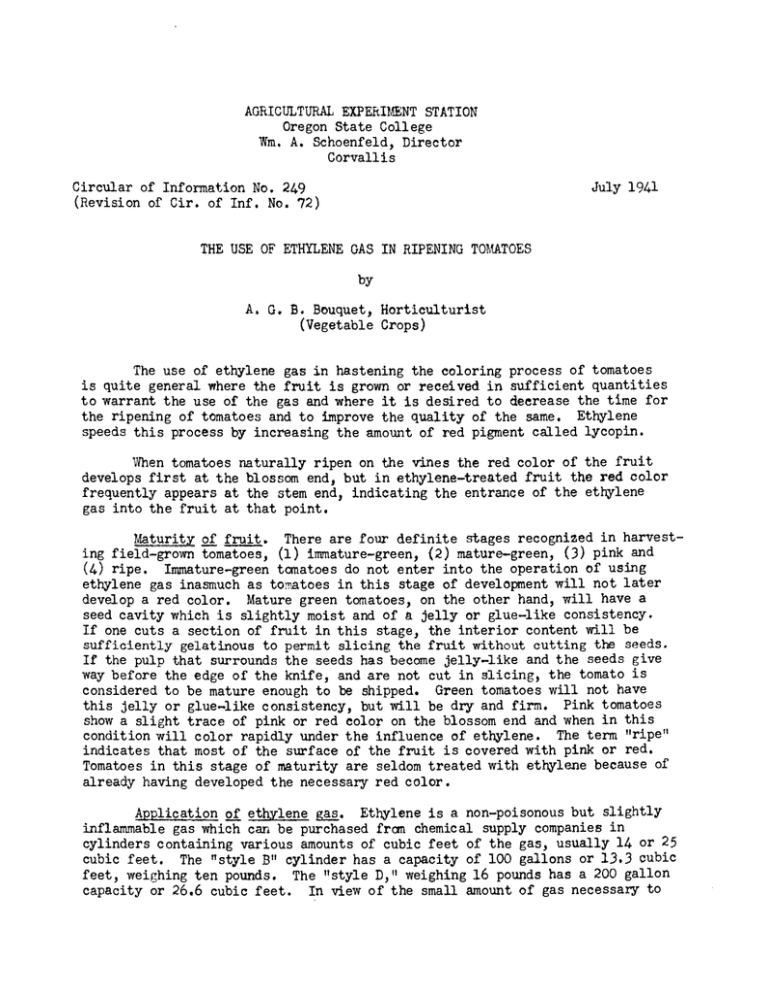
AGRICULTURAL EXPERIMENT STATION Oregon State College Wm, A. Schoenfeld, Director Corvallis July 1941 Circular of Information No. 249 (Revision of Cir. of Inf. No. 12) THE USE OF ETHYLENE GAS IN RIPENING TOMATOES by A. 0. B. Bouquet, Horticulturist (Vegetable Crops) The use of ethylene gas in hastening the coloring process of tomatoes is quite general where the fruit is grown or received in sufficient quantities to warrant the use of the gas and where it is desired to deerease the time for Ethylene the ripening of tomatoes and to improve the quality of the same. speeds this process by increasing the amount of red pigment called lycopin. When tomatoes naturally ripen on the vines the red color of the fruit develops first at the blossom end, but in ethylene-treated fruit the red color frequently appears at the stem end, indicating the entrance of the ethylene gas into the fruit at that point. Maturity of fruit. There are four definite stages recognized in harvesting field-grown tomatoes, (i) inmiature-green, (2) mature-green, (3) pink and (4) ripe. Innature-green tanatoes do not enter into the operation of using ethylene gas inasmuch as toiiiatoes in this stage of development will not later develop a red color. Mature green tomatoes, on the other hand, will have a seed cavity which is slightly moist and of a belly or glue-like consistency. If one cuts a section of fruit In this stage, the interior content will be sufficiently gelatinous to permit slicing the fruit without cutting the seeds. If the pulp that surrounds the seeds has become jelly-like and the seeds give way before the edge of the knife, and are not cut in slicing, the tomato is considered to be mature enough to be shipped. Green tomatoes will not have this jelly or glue-like consistency, but will be dry and firm. Pink tomatoes show a slight trace of pink or red color on the blossom end and when In this condition will color rapidly under the influence of ethylene. The term "ripe" indicates that most of the surface of the fruit is covered with pink or red. Tomatoes in this stage of maturity are seldom treated with ethylene because of already having developed the necessary red color. Application of ethylene g. Ethylene is a non-poisonous but slightly inflammable gas which can be purchased frczn chemical supply companies in cylinders containing various amounts of cubic feet of the gas, usually 14 or 25 cubic feet. The "style B" cylinder has a capacIty of 100 gallons or 13.3 cubic feet, weighing ten pounds. The "style D," weighing 16 pounds has a 200 gallon capacity or 26.6 cubic feet. li-i view of the small amount of gas necessary to Pr The 26 cubic foot be used, the smaller sized cylinders are more desirable. size contains a sufficient amount of gas to ripen 5 ci' more carloads of fruit. A 200 gallon supply gas tank can be purchased at about $5.50, together with an extra charge of $8.00 for the cylinder, which charge is returnable. In handling The ethylene gas is under high pressure in a steel cylinder. The tanks should be kept the cylinders care must be used not to drop them. Light away from stoves or boilers and not be allowed to lie in hot sunshine. from fires should be kept away from them in order to avoid the ignition of the gas which may leak from unclosed valves. During liberation of the gas from the tank, open light, cigarette, cigars or pipes should nt be allowed in the room. Incandescent electric lights are safe and actually the danger in handling ethylene is about the same as allowing a very small jet on a gas stove to run unhighted for the same length of time. Since the pressure on a full cylinder of ethylene is so high, a special expansion valve must be used for the measurement of the dose of gas required. This valve should be attached to the cylinder securely with a lead gasket to kiter attaching prevent leakage between the expansion valve and the cylinder, the expansion valve, see that the thumb screw on it is turned in the direction of "Close" until the pressure of the spring is released; then the valve on the cylinder should be completely opened. Always use the valve on the tank as the shut-off valve. Do not use the expansion valve to stop the flow of gas. A constant low-pressure expansion valve discharging through a very small orifice is the most convenient means of measuring the gas, for at a constant low pressure a uniform number of cubic feet of ethylene will flow through the orifice per minute. A watch may then be used to find the flow in liberating the required volume of gas. The number of cubic feet of ethylene delivered per minute is stated on the dial surface. The measuring device regulates the amount of gas released per minute, the dial registering the flow being calibrated to .2 of a cubic foot per minute. Thus, when the arrow is pointing to 2 it shows that the ethylene is passing out of the tube at the rate of .2 of a cubic foot per minute or 1 cubic foot in five minutes. Amount needed. To determine the dose of ethylene required for a certain room, measure its height, length and breadth and multiply these together to obtain the cubic feet o air ccntained in the room, Thus, a room 8 feet high, 20 feet long and 12 feet wide contains 1920 cubic feet, or a room 20 x 15 x 10 contains 3000 cubic feet. Since the usual dosage is 1 cubic foot of ethylene to 5000 cubic feet of air space, the amount f ethylene to be liberated in the case of the first room would be approximately .40 cubic feet or in the case of the second room, .60 cubic feet. Delivering a dose of .4 cubic feet of ethylene into a room at the rate of .20 cubic feet per minute, two minutes would be required. Open the valve on the tank and screw in the thumb screw on the expansion valve until the pointer on the gauge stands constant at the point marked to deliver .2 cubic feet per minute. As soon as the pointer reaches this mark note the exact seconds on the watch. Allow the gas to flow for the time necessary to release the required dose as determined beforehand. Then quickly close the valve on the cylinder and place it with the pointer on the expansion valve at 0 The next morning after the first application f gas the room should be recharged as before. Ordinarily, two to three doses for tomatoes are all that is required. The room for holding the gas in ripening fruit should be constructed so that there may be little or rio leakage of the gas. It is desirable to have a temperature of between 65 and 70 degrees F. for the ripening of tomatoes and a relative humidity at about 90 per cent. One grower conceived the idea of building a cabinet having a capacity of 1000 pounds, occupying 8 square feet of floor space) and having a cubical It was built air-tight of insulating material, capacity of about 30 cubic feet. and contains a hot water device necessary to bring the cabinet up to the desirable temperature of 70 degrees. The ripening capacity of this cabinet is between 100 to 200 pounds of ripe fruit daily, with a gas conuxnption of about 1/15 of a cubic foot, costing less than 2 per application. The tomatoes can be ripened in standard containers for the gas will package. readily penetrate the average style of Under ethylene treatment tomatoes take on a bright red color in from 4 to 6 days, depending upon the state of maturity when treated. Fruits treated artificially with ethylene are said to have a better flavor and decreased acidity in comparison with those fruits ripening on the vines, or ripening naturally when picked in a maturergreen condition. This method of increasing the red pigment of the fruit should be particularly useful for the treatment of tomatoes picked in a mature-green stage just after light frosts in the fall, Such fruits must, of course, be unfrozen and should be picked carefully so as not to be bruised and should be put away in a cool room to be later treated with ethylene. It is not desirable to treat tcnatoes that have ripened further than the pink or turning" stage of coloring, otherwise the fruits are liable to rot in being exposed to the necessary temperature and humidity required for ethylene treatment. tomatoes. On the basis that certain ripe Use of ripe apples in treatj fruits such as apples and pears give off ethylene, boxes of mature green tomatoes were put into a ripening room without any ethylene application. Some Others had no fruit boxes of tomatoes ccntained in them a few ripe apples. placed among the tomatoes. The boxes containing apples and tcinatoes were sealed. Those without the fruit were left unsealed. The storage temperature was between 68 and 72° F. At the end of 10 days, 98 per cent of the tomatoes in the sealed boxes ripe, the remainder being yellow to half-red. In the unsealed boxes containing tomatoes alone, 33 per cent were still green, 19 per cent were yellow to half red, while 45 per cent were colored and ripe. were colored arz pe apples are used, one bushel box of fruit should be effective in If producing a sufficient amount of ethylene gas for a chamber of 500 cubic feet, 4 The supply of ethylene given f I by the ripe fruit is constant and thus is useful in affecting numerous lots of tomatoes to be treated. Useful References U.S.D.A. Farmers' Bulletin 1291. U.S.D.A. Circular 566. Preparation of Fresh Tomatoes for Market. Ripening and Repacking of MatureGreen Tomatoes. Oregon State College Extension Circular 311. Oregon Experiment Station Bulletin 324. Gases other than Carbon Dioxide. Growing and Marketing Tomatoes. The Occurrence in Pears of Metabolic
